by Kenan White | Jan 13, 2022 | Basics, Books & Design, Flowers, Gardening, Herbs, Inspiration, Miscellaneous, Wildlife |
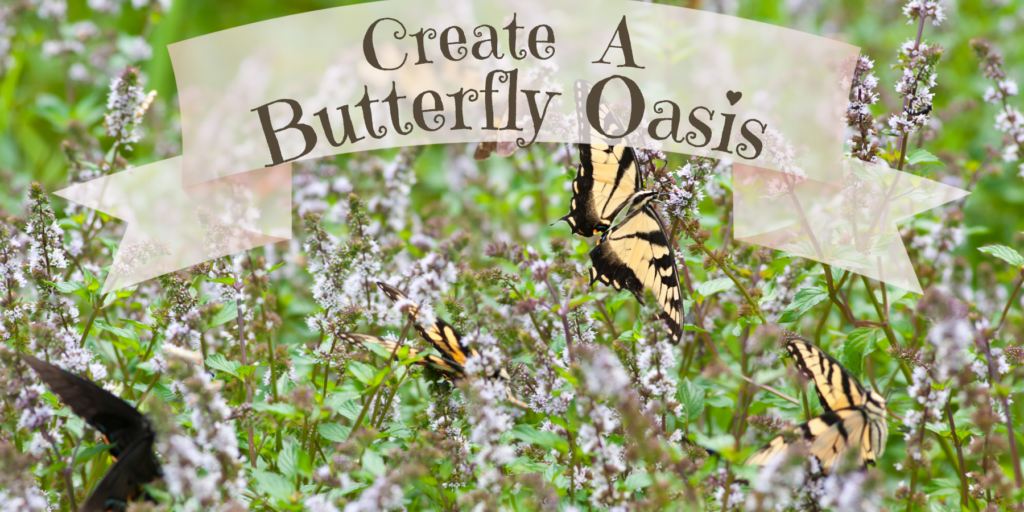
Butterfly gardening can be a wonderful way to experience wildlife in your garden, encourage pollination, and it takes very little maintenance, giving you more time to enjoy the beauty of watching butterflies flock to your plants. Many people who have maintained a butterfly garden for such a long time actually enjoy having visitors to come and look at their creation. This is also a great way to give back to your local ecosystem, as many natural habitats for butterflies and other pollinators have been destroyed by urban development and human interference. We always let about half of our test garden go wild in the summer, in addition to the many flowering shrubs and trees throughout the yard, to give butterflies a safe place to feed and lay their eggs. This is common practice, and we let this happen until the flowering shrubs and trees start to become an issue.
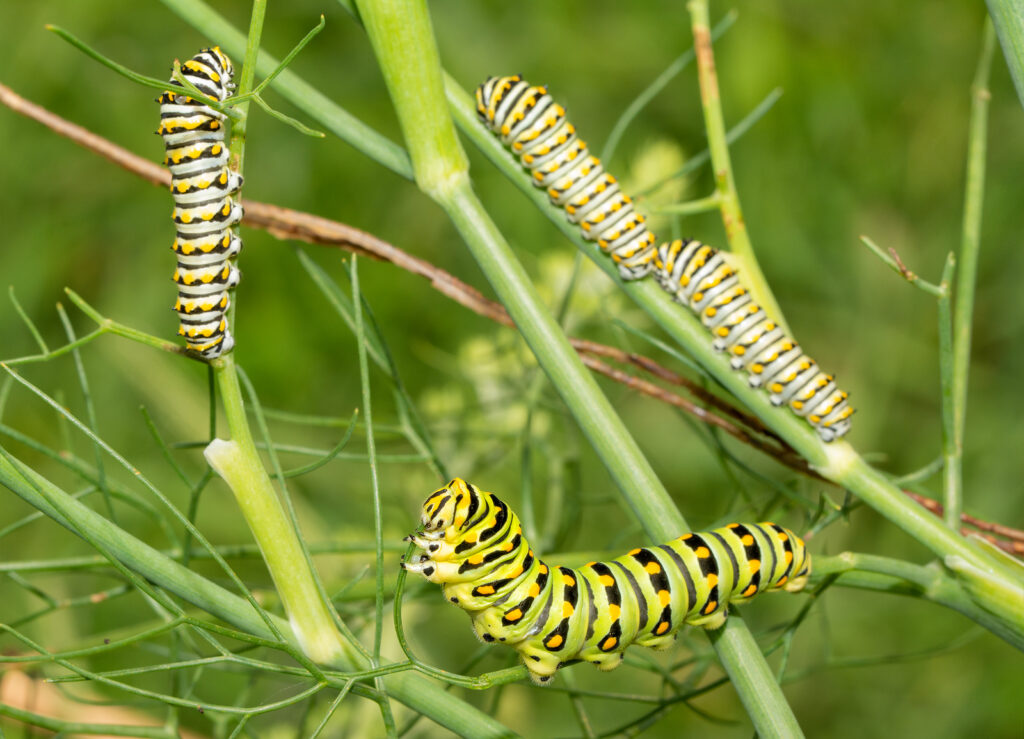
Here’s a wonderful photo showing a Fennel plant hosting Eastern Black Swallowtail butterfly caterpillars
In planning your butterfly garden, make sure to plant plenty of host plants and feeder plants. Host plants are specific herbs, flowers and other plants, that mature butterflies lay their eggs on because they create a safe haven for their young who will also feed on these plants once they become caterpillars. Be aware that these plants will be the sole food source for caterpillars, so it will be pretty heavily snacked upon. Because these may look rather ragged by the time the caterpillars are done munching on them, you may want to add these to the back of your garden, but still close to feeder plants so that the caterpillars are able to find them easily in their next stage of life. Some common host plants include Fennel, Italian Flat Leaf Parsley, Dill, Broccoli, Sunflowers, and Butterfly Flowers (also known as Milkweed).
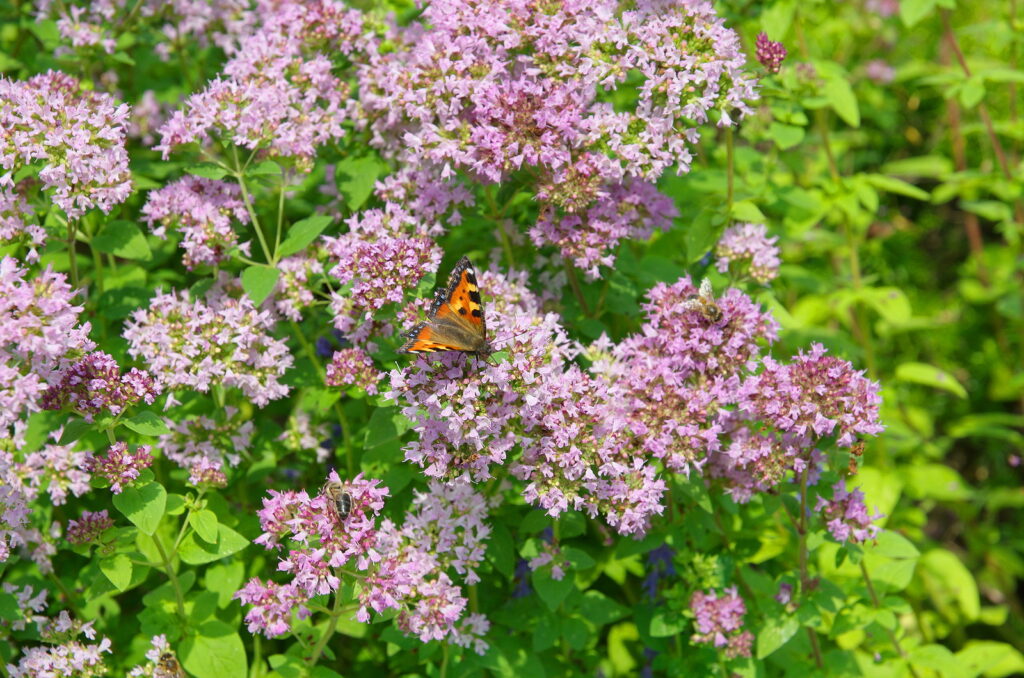
Butterfly on the flowers of oregano (lat. Origanum vulgar)
Feeder plants are nectar rich plants that adult butterflies will feed on throughout the season. These will also attract other helpful pollinators to your garden like honeybees and hummingbirds! Feeder plants tend to be fragrant and brightly colored, and you may be surprised to find that you already have many in your garden already. Some common varieties from our garden include Lantanas, Buddleias (also known as “Butterfly Bushes”), Joe Pye Weed, Bee Balm (Bergamot), Garlic Chives, and Oregano.
- Remember to plant your perennial butterfly plants toward the back of your garden and your annuals toward the front, for easy seasonal replacing.
- Don’t forget to incorporate herbs into your butterfly garden! Many herbs are perennial and will provide you with a safe haven for caterpillars and beautiful blooms when they flower. You can also use them in many other ways!
- Choose an area that is protected by the wind, as butterflies are delicate and don’t want to fight strong breezes to feed.
- Provide a water source, such as a birdbath or a shallow bucket filled with water with sand in the bottom.
- Avoid using pesticides on your plants as these will harm the butterflies and their young.
by Kenan White | May 21, 2012 | Books & Design, Flowers, Gardening, Herbs, Life on the Farm, Miscellaneous, Wildlife |
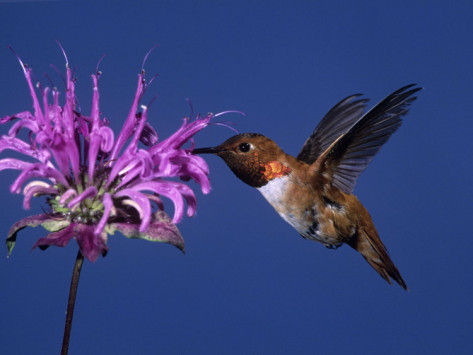
Hummingbirds love sweet,tubular-shaped flowers like those of the Bee Balm herb plant.
We absolutely LOVE watching hummingbirds dart through our gardens on a warm Summer evening. Attracting hummingbirds to your garden is a wonderful way to enjoy seeing these fast-flying little birds’ aerial antics up close, and will provide you with hours of entertainment from Spring until Fall. Also a very beneficial garden companion, hummingbirds will eat bugs and help increase pollination in your garden be flitting from bloom to bloom.
Hummingbirds do not have a sense of smell, and are instead attracted to brightly colored (usually red), trumpet or tube shaped flowers which their long beaks are specially designed to drink from. Because hummingbirds fly so fast (up to 30 miles per hour!), they spend most of their time foraging to keep their energy levels high. Their need for fuel is so high that hummingbirds may drink up to eight times their body weight in nectar in a day!
Make sure to plant these hummingbird friendly herbs and flowers to make your garden a great place for hummingbirds to feed:
We also have a variety of hanging and staked feeders that are specially designed to attract hummingbirds. Made from recycled glass, the colors change from a lovely orange and yellow color to a vibrant flame red that hummingbirds are drawn to. Click here to view our video and watch the hummingbirds swarm these lovely, hand crafted feeders.
Other tips for creating a hummingbird haven in your yard:
- Place hummingbird feeders near your garden to attract hummingbirds to your plants.
- Place the feeders at different heights throughout your yard and garden, as some species prefer different feeding patterns. Placing feeders in different parts of your yard will help keep territorial males from dominating all of the nectar.
- Make sure to keep your feeders clean and full of fresh nectar to ensure that the hummingbirds don’t get sick. Cleaning the sugary substance from the feeder’s holes may also help prevent attracting bees or wasps, as they may convene to find leftovers.
- Make sure to offer a good, clean water source for the hummingbirds to drink and bathe in, such as a bird bath which is shallow enough for them to play in.
- Add strings that run the length of your garden, above your plants to give hummers something to perch and rest on while flitting from flower to flower.
by Kenan White | May 3, 2012 | Books & Design, Containers, Exploring, Gardening, Growing, Herbs, Inspiration, Life on the Farm, Miscellaneous, Recipes |
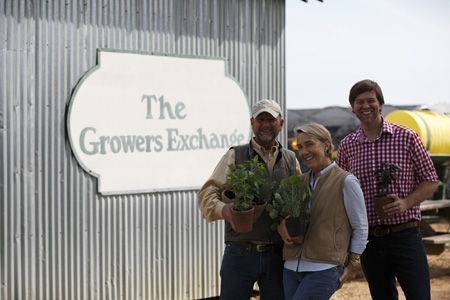
We had a great time showing James all around the farm- we even sent him home with some potted herb souvenirs!
Last week, our good friend, James Farmer came up for a demonstration on garden to table living and while here, he stayed in the cottage on our farm. We had a wonderful time strolling through the test gardens, talking about his favorite culinary herbs for his infamous Southern recipes, and chatting about country life, gardening and everything in between!
In the greenhouse, James discovered the benefits of Holy Basil and even helped us pot his very own herb garden kit, the James Farmer’s Favorites Herb Collection, where he includes his favorite culinary herbs for making his delicious drinks and dishes.
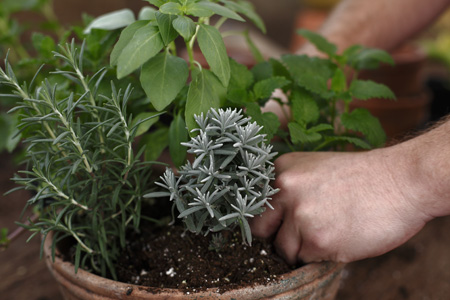
Our newest herb kit, the James Farmer's Favorites Herb Collection was hand picked by James himself!
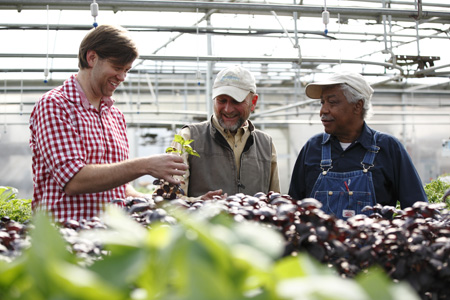
We introduced James to Holy Basil and taught him about its rich history and wonderful medicinal benefits.
When walking through the test gardens, we discussed the investment and versatility that perennial herbs lend. For example, I showed James that more than just a beautiful flower for the garden or in arrangements, Pyrethrum is a natural insect repellent and is used in many organic insecticides.
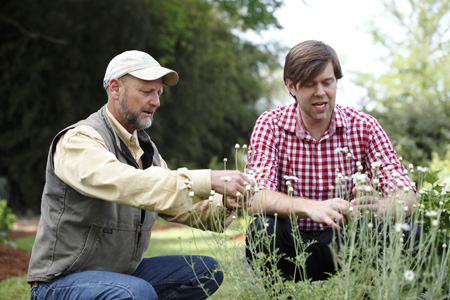
"Pyrethrum is beautiful in the garden or in arrangements, and is also a natural insect repellent used in many organic insecticides."
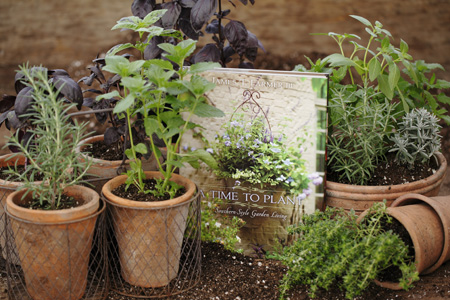
You can purchase James’s book, A Time To Plant: Southern-Style Garden Living and get loads of design tips, recipes and more, AND six of his favorite culinary herbs to create endless concoctions and dishes when you buy the James Farmer’s Favorites Herb Collection and Book!

We had such a wonderful time with James on the farm, we can't wait until he comes for another visit!
We had a such a fantastic time with James and can’t wait for him to come back! For more information on James, or his newest release, Sip and Savor: Drinks For Party and Porch, please visit his website!
by Kenan White | Apr 25, 2012 | Basics, Books & Design, Flowers, Gardening, Herbs, Inspiration, Life on the Farm, Miscellaneous, Recipes |

We are so excited that our good friend, James Farmer is coming to visit and stay at our farm this week! As part of Virginia’s Historic Garden Week, James is coming to visit and give us an exclusive demonstration on his garden to table arrangements as well as share some of his favorite food and drink recipes from his two books, A Time To Plant: Southern-Style Garden Living, and Sip and Savor, Drinks For Party and Porch, which was just released. James has a wonderful eye for design and has used his talents to bring gardening to a gourmet level. Throughout his elaborate table settings, stunning arrangements and in his Southern-chic food and drink recipes, James incorporates his passion for herb gardening for a refined but “down home” feel. As the most creative new personality in the garden living world, James still stays true to his Southern roots, drawing his inspiration from his family farm in Kathleen, Georgia.
![Time-Plant-Cover-02[1]](https://theherbexchange.com/content/uploads/2012/04/Time-Plant-Cover-021-388x500.jpg)
James Farmers Favorites
To celebrate James’s visit to our farm and his fantastic new book, A Time To Plant, Southern Style Garden Living, we’ve created the James Farmer’s Favorites Herb Collection to offer some of his favorite herb plants! We’ve included Lavender ‘Hidcote’, for its beauty in arrangements or as a garnish, and for its wonderful fragrance and light, floral flavor in drinks and recipes. For a true Southern experience, we added ‘Kentucky Colonel’ Mint, a robust spearmint that grows effortlessly and is the key component to a real Southern tradition, the Mint Julep. ‘Lemon Sweet Dani’ Basil was chosen for its delicate citrus tones and lovely blooming spires, making it perfect for flavoring seafood, salads and garnishing summer desserts. To share a savory note, we also added our Rosemary ‘Arp’, a flavorful, cold hardy, Rosemary that seasons meats, stews and full flavored desserts. (James loves using the Rosemary twigs as skewers for adding fruit kebabs to his delectable drinks!) Rounding out his favorites, are ‘Italian Flat Leaf’ Parsley for its full body flavor and lovely leafy foliage, and ‘English’ Thyme, a classic culinary herb that grew in his grandmother’s kitchen garden and of which he has fond, flavorful memories.
We have even included the option to buy either this collection of six culinary herb plants to get your garden started with Southern style, or the James Farmer’s Favorites Herb Collection AND James’s new book, A Time To Plant, Southern-Style Garden Living, for a lovely added gift.
If you may already have these wonderful culinary herbs in your garden, you can purchase A Time To Plant: Southern-Style Garden Living sold separately. Whether you treat yourself or give this as a thoughtful gift, the James Farmer’s Favorites will be a sure delight for entertaining in the garden and in your home!
by Kenan White | Apr 19, 2012 | Basics, Books & Design, Flowers, Gardening, Herbs, Inspiration, Life on the Farm, Miscellaneous, Urban Gardening |
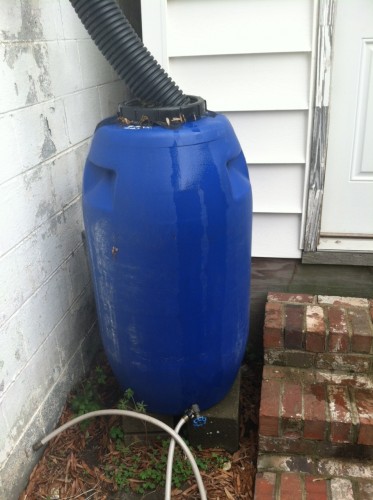
Rain barrels are easy and very inexpensive to make and you'll save lots of water, time and money.
In keeping with our green theme this week for Earth Day on April 22nd, here’s another great project that your plants will appreciate! Our Marketing Director, Caroline and her boyfriend built the one above, for their gardens last summer.
She swears by her backyard barrel, ” This is a great alternative to the chemicals in city water and to paying city water bill prices! My herbs and his tomatoes went wild over this water last summer!”
Reduce your water use considerably by building a rain barrel. Watering your plants with rainwater is better for them than tap water because of all of the minerals that collect in the rainwater that feed the plants. Also, many municipal water systems treat their water with chlorine and fluoride, which can build up in your soil over time and reduce its quality. Watering your gardens may also use quite a bit of water, and especially in the summer when things are extremely dry, some areas institute mandatory water restrictions. Having your own rain barrel also reduces runoff which can carry lots of pollutants back into the water system, and it allows you to have a source of water in a part of your yard that may not have a spigot nearby. A rain barrel will keep your plants healthy and well watered, save water, and save you money! You can also decrease debris and pollutants by installing gutter guards into your gutters around the exterior of your house, companies such as Mastershield Atlanta as well as other companies can provide you with these gutter guards.
Building a rain barrel is easy and very cheap if you have the right resources.
- Start with a large food barrel that you’ve rinsed thoroughly. Place it on top of four cinder blocks that are laying flat on the ground. (This will help to give the barrel more height and better gravity, allowing the water to flow better once it gets to a lower level.) Large restaurants receive shipments of these barrels all of the time, and if you can’t get one directly from them, try looking online. We found the barrel pictured above in a garden listing on Craigslist, and it once held A LOT of olives.
- Using a Dremmel tool or saw, cut a 6″ hole in the top of the lid, so that the center is hollow but you can still screw the cap onto the top of the barrel.
- Take a piece of old window screen and cut it so it just fits the top of the barrel, while still allowing you to screw the top in place. Make sure the screen is well fitting, as this will keep insects and debris out of your water.
- Drill a hole at the bottom front of the barrel that is just slightly smaller than a small spigot that you can find at your local hardware store. Fit the spigot into the hole for a very snug fit (this prevents you from having to use chemicals to seal the spigot into place.)
- Place beneath or connect to your gutter runoff spout. Then, just wait for it to rain! Your barrel will fill with rainwater and you can water your flowers and herb plants with a watering can or by attaching a short length of hose.
by Kenan White | Apr 12, 2012 | Basics, Books & Design, Flowers, Gardening, Growing, Herbs, Life on the Farm, Miscellaneous |
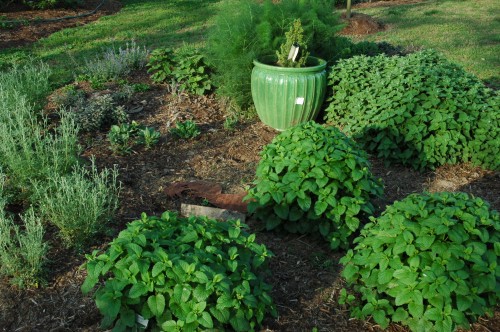
Spring is here and there is nothing more beautiful than looking out at perfectly shaped herb plants, thriving in our test garden. We planted these perennials in our test garden this past Fall and with our mild winter here in zone 7b this year, they’re all well established and growing vigorously. To help cut back on spring chores and to ensure less stress to many of these plants (especially the woody perennials) we pruned them in early February for healthy new foliage this spring.
There are different types of pruning methods, depending on the type of herb. Woody perennials, like Rosemary need to be hard pruned while the weather is still cold in early spring, so that it causes the least amount of stress to the plant. Hard pruning means cutting the plant back to the more mature wood, where there is no sign of tender new growth. This directs the plant’s energy to the newly trimmed area to encourage new, lush growth once the temperatures warm. You can prune up to about one third of the plant, and then give it more frequent “haircuts” throughout the rest of the year to keep the foliage nice and green. For a great video on hard pruning your woody perennials, check out our video where I prune the Rosemary ‘Salem’ in our test garden!
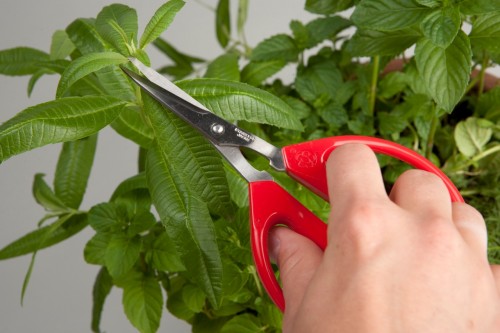
For leafy herbs like Italian Flat Leaf Parsley, make sure you prune your plant around the outside, leaving the new growth in the middle. As the plant grows, the older foliage gets pushed to the outside, as the tender new leaves emerge in the middle. Once you trim your leafy herbs, you should see vigorous new growth as the plant redirects its energy toward producing new leaves. Here’s a great video on pruning Parsley to give you some inspiration!
Pruning can be rather scary for new gardeners, as the thought of cutting the plants you’ve worked so hard to grow can feel a bit like a step in the opposite direction. Don’t worry! Plants appreciate a good spring cleaning and a little trim around the edges to really allow them to flush out as the weather gets warm. Always make sure to use clean, sharp pruners or scissors for a healthy cut and your plants will bounce back even better than before!












![Time-Plant-Cover-02[1]](https://theherbexchange.com/content/uploads/2012/04/Time-Plant-Cover-021-388x500.jpg)


